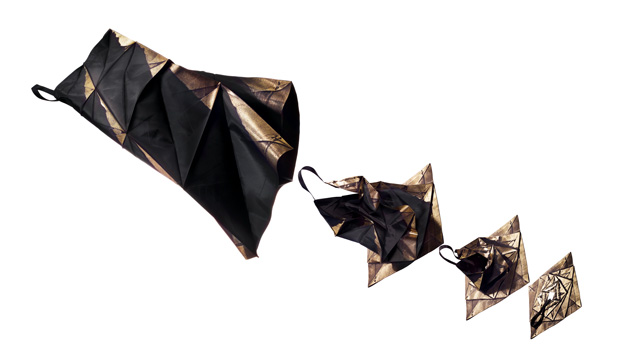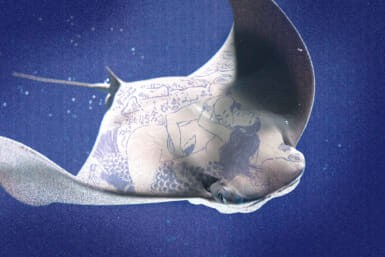After a more than 10-year stretch in which the quintessentially Japanese designer has overseen the production of clothes under his label by other creators, this week the master has returned with an origami-inspired collection that has arrived just in time for serious fashionistas to jot down on their Christmas wish lists.
BY DANIELLE DEMETRIOU
The Japanese designer has just unveiled his first new collection in 13 years with a range of clothing inspired by the intricate world of origami. Called 132 5, the new range is as unconventional as it is avant-garde. Each piece, cut from a single sheet of fabric, starts life flat packed, its surface intricately crossed with geometric lines that reflect each fold.
The pieces, however, lightly spring from their two dimensional form into three dimensional garments with a gentle transformative tug — resulting in a sculptural collection of angular dresses, arm pieces and bags.
The 132 5 name encapsulates all these facets of the items: 1 is for one piece of cloth; 3 for the three dimensions of the clothing; 2 for the two dimensions of the folded dress: 5 for the action of the dress being worn in the four combined dimensions of space and time — ponder that for a moment.
Given Miyake’s creative heritage, it is not surprising that the new garments were not unveiled at a fashion show but in the minimalist confines 21_21 Design Sight museum in Tokyo’s Midtown complex. The exhibition showcasing the new line is called “Reality Lab” — the same name that is used by the team of around a dozen or so Issey Miyake designers who helped to create the new 132 5 collection with him.
It quickly becomes clear upon entering the exhibition space that 132 5 is no conventional fashion line. Made 100 percent in Japan, pattern cutters, scientists, engineers, artisans and regional factory workers joined forces in an unlikely collaboration to create the new collection. The starting point is computer software developed by the scientist Professor Jun Mitani, who produced special computer programs capable of creating complex origami designs and translating these into patterns for clothes.
The fabric itself is equally arresting: Teijin, the Japanese textile company invented a high-tech recyclable polyester made in part from plastic bottles. Threading the technology together are Japan’s traditional artisan roots: The pieces were woven in Fukui Prefecture, dyed at a factory in Ishikawa and foil stamped in Osaka to create an abstract metallic surface.
Displayed in the main area of the exhibition at 21_21 are the results, with neatly folded, geometrical, flat packages of cloth sitting next to mannequins that wear each dramatic statement piece in all its unfolded glory.
But it is the journey taken by each piece — as reflected in a series of installations, videos and displays detailing the manufacturing process throughout the exhibition — which is as important as the end result, according to Miyake.
“How do we resuscitate the art of making things” he asks, “(and) the spirit that inspires people in the same way as it did during the era when individuals and companies alike showed enthusiasm and found great joy and pride in the quality and beauty of their work?
“I want everybody to start thinking about the meaning and significance of rebirth and re-creation: design activities that create ‘reality’.”
For Miyake, now aged 72, the art of creating has long been a central motif to his life. After graduating in graphic arts from Tama Art University, the Hiroshima-born designer spent stints working in fashion in Paris and New York before setting up his own studio in Japan in 1970. Since then, Miyake’s name has become a byword for iconic Japanese fashion, with previous collections ranging from his signature Pleats Please range to the innovative single piece A-POC designs.
But the designer has long struggled with the confines of creative labels, as reflected in the fact that his pieces are perhaps just as likely to turn up in a museum, art exhibition or theater stage as on a catwalk or even in a wardrobe. Further testimony to his success in defying the “fashion designer” label is the fact that five years ago, Miyake was awarded the Praemium Imperiale — Japan’s most high-profile arts prize — not for fashion but, in an inspired turn, for sculpture instead.
His latest 16-piece collection, which is now on sale in newly opened 132 5 stores in Tokyo, London, Paris and Zurich, is not only an exercise in creativity, but is also firmly tied to the Japanese tradition of high quality manufacturing.
His fears about the future of Japan’s once famed manufacturing industry prompted the creation of the new collection in the first place, according to Miyake. Describing the “crisis” facing Japan’s production industry, the designer warns that countless factories are closing as production is increasingly relocated overseas to countries with lower labor costs. As a result, the nation’s heritage of creating hand-crafted products is in danger of dying out.
Highlighting how this has led to the creation of 132 5, he says that “with the help of those engineers and craftsmen whom I met through our research, and textile factory people I have long worked with, I wish to create clothes that use the best of the special technical skills of these people.”
Fusing heritage with creativity and the past with the present, the new collection most certainly achieves this. — (W)
Issey Miyake’s new 132 5 line of origami-inspired dresses, skirts and tops is currently on sale in London, Paris, New York, and in Tokyo at a dedicated shop at 5-3-10 Minami-Aoyama (03 3499-6476; 11 am-8 pm). Prices range from ¥28,000 to ¥85,000. For more information, visit www.isseymiyake.com
“Reality Lab”, the exhibition showcasing the new 132 5 collection and its production process, is at 21_21 Design Sight in Tokyo until Dec. 26.
For more information, visit www.2121designsight.jp










